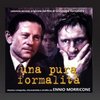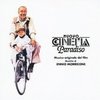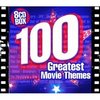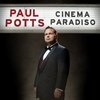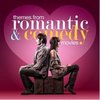Soundtrack Information

Cinema Concerto: Ennio Morricone At Santa Cecilia
Sony Classical (SK 61672)
Release Date: 2000
Conducted by Ennio Morricone
Performed by
Orchestra And Chorus Of The Accademia Nazionale Di Santa Clara
Format: CD
Music From
Music By
Track Listing
Related Albums

Cinema Paradiso - 30th Anniversary Remastered EditionLimited Collector's Edition of 500 Units
Quartet RecordsReleased: December 10, 2018
Format: CD (53 min)

Indagine su un cittadino al di sopra di ogni sospettoLimited Edition
AMS Music (AMS LP 94)Released: October 9, 2015
Format: Vinyl

Indagine su un cittadino al di sopra di ogni sospetto / Il giocattoloCinevox
Released: January 12, 2014
Format: Digital (51 min)
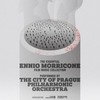
The Essential Ennio Morricone Film Music CollectionSilva Screen
Released: June 24, 2016
Format: Digital (146 min)
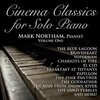
Cinema Classics for Solo Piano: Volume OneBSX Records
Released: March 15, 2013
Format: Digital (77 min)

Ennio Morricone: Deluxe CollectionC.R. Digital Contents
Released: January 30, 2007
Format: Digital (132 min)

Ennio Morricone: Deluxe CollectionC.R. Digital Contents
Released: January 30, 2007
Format: Digital (132 min)

Hollywood Bowl Orchestra - Greatest HitsPhilips (289 468 686-2)
Released: May 11, 2001
Format: CD (131 min)
Review: Cinema Concerto: Ennio Morricone at Santa Cecilia
3.5 / 5 Stars
At seventeen tracks and over an hour of music, we get a collage of Morricone's common styles and most recognizable themes. The album opens with two tracks from the highly acclaimed film Cinema Paradiso, very beautiful and lyrical, in almost evokes a dream-like state. It's a very beautiful piano theme on the first piece and a woodwind theme on the second track, flowing and lamenting. It is not unlike what Morricone used for a later collaboration with Giuseppe Tornatore on The Legend of 1900 last year, and setting up a very fruitful musical relationship. A Tornatore directed film shows up again on track four for "Ricordore" from A Pure Formality, a very haunting set of vocals accompanying a mourning melody. In between, is from a lesser known film, A Citizen Above Suspicion, and musically is very similar to what could be called the "gangster" style that Morricone used in such films as The Untouchables and State Of Grace. A theme that is very heavy on the string section, later augmented by percussion infusing the woodwind themes with suspense.
Next on the trip through Ennio's past is his collaboration with American director, Barry Levinson (Avalon and Homicide: Life On The Street) on the Annette Benning and Warren Beatty starrer Bugsy. Ennio later worked with Beatty on his political satire, Bulworth, which is excluded from this collection. This suite meanders around all over the place musically, never quite settling on a recognizable theme, a real low point on the album. However, the following track from the Italian comedy, H2S, allows Ennio to jump film genres to lighter fare, and he handles it with ease, and with a surprising enjoyable melody. In the middle of the album we switch into the spaghetti western stage of Ennio's career with the legendary Sergio Leone with suites from Once Upon A Time In The West, A Fistful of Dynamite, and the always recognizable themes from The Good, The Bad, And The Ugly. The way these pieces were recorded, they have the same feel of many of the Erich Kunzel and Cincinnati Pops recordings on Telarc, a very open and "pop-sy" feel, not the usually constrained and studio sweetened versions that folks are accustomed to on regular soundtrack albums. I do like these re-arranged suites since Mr. Morricone has had a chance to fill out, instrumentally, in the orchestra, what he couldn’t do over thirty years ago when they were first released. These are the highlight pieces of the album, and if you only get the album for them, you really won't be too disappointed.
For the last third of the album, we traipse through some of Ennio's darker but more passionate music from films such as Pereira Declares, Love Circle, Casualties of War, and The Working Class Goes To Paradise. The latter track being one of the most annoying on the album due to it's instrumentation and synthetic percussion that offsets it so musically that it's more of a distraction than anything. His work on the Brian DePalma helmed film, Casualties of War is in stark contrast, quality wise, to his work on Bugsy, with a beautiful choral accompaniment and full orchestra. It's very much on par with Georges Delerue's rejected work for Platoon (which had a very similar theme and setting) and is one of the collector favorites of Morricone's more recent works. The track in between Casulaties of War and the two selections from Ennio's most recognizable work outside of The Good, The Bad, And The Ugly and The Mission , is from a little seen film, Burn!. Who ever put the album together in the latter stages definitely knew what they were doing by using this odd choral-percussion-organ combination piece as a transition between the styles. It's oddly uplifting, and musically it's kind of interesting to listen to. Morricone has also proved, outside of getting the most out of an orchestra, he can really utilize a chorus as heard representative pieces here as well as on such scores as Red Sonja and The Mission.
The album ends with the two most heard, and in my honest opinion, best themes from The Mission, "Gabriel's Oboe" and "On Earth As It Is In Heaven." Although I prefer the soundtrack versions of these pieces over the ones presented on this album, it's not to say that the arrangements here aren't good. "On Earth As It Is In Heaven" on the original soundtrack is a bit more on the percussion, which, on this arrangement, doesn't make an appearance until the end. Overall, fans of Morricone will enjoy this album, even if it doesn't encompass a majority of his works. I would say that a compilation of works, perhaps on a two or three CD set utilizing the same chorus and orchestra used here would be an idea, maybe not. This was a concert, and the selections presented are only selections, and not the entire program of what was presented. It's a step in the right direction, now only if we could get other film composers to do similar projects.
-
Click stars
to rate.
If any information appears to be missing from this page, contact us and let us know!


